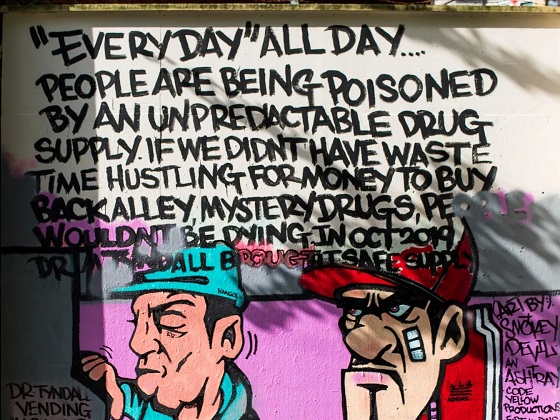Opinion
Misleading polls may produce more damaging federal policies

From the Fraser Institute
By Jason Clemens and Jake Fuss
72 per cent of respondents in Canada supported a new narrowly-targeted tax on wealth for the top 1 per cent to pay for new government services and/or a guaranteed annual income. But support dropped to only 16 per cent when the plan relied on increasing the GST to 20 per cent. The implications of the data are clear—Canadians support new and expanded programs when they believe someone else will pay for them.
In the wake of the 2024 federal budget, several public opinion polls have been released with potential implications for the future direction of federal policy. But unless the polls are interpreted correctly, the results could be misconstrued and lead to further damaging federal policies.
Most polls continue to show the federal Opposition significantly outperforming the governing Liberals and their partners in government, the NDP. Moreover, polls completed after the Trudeau government released the federal budget earlier this month indicate Canadians generally do not agree with the overall policy direction of the Trudeau government.
For example, according to a recent Leger poll, 56 per cent of Canadians believe the country is “headed in the wrong direction,” 59 per cent “perceive the economy as weaker,” only 19 per cent agree the government’s strategy “will benefit their personal finances,” and only 33 per cent believe the government is “taking positive steps to grow the Canadian economy.”
These results align with a recent Angus Reid poll, which found that 59 per cent of respondents think federal spending had grown too large and spending cuts were needed.
A number of pollsters, however, have noted the gulf between the overall lack of support for federal policies (including the recent budget) and strong support for individual initiatives in the budget. According to the Leger poll, for instance, 73 per cent of respondents support the new $6 billion Canada Housing Infrastructure Fund, 71 per cent support the new National School Food Program, and 67 per cent support the new $15 billion Apartment Construction Loan Program.
But these results are misleading because they only reflect one side of the question—the benefits. In other words, the polls ask respondents if they support specific programs but exclude any costs. When Canadians understand the costs, their attitudes change. They’re concerned about the level of federal spending because they see the costs—rising taxes, mounting debt and increasing interest costs.
Not surprisingly, when pollsters connect new or expanded programs with their costs, support for those programs declines. Consider a 2022 Leger poll that asked respondents about their support for pharmacare, dental care and the federal $10-a-day daycare program.
Support for the three programs is strong when no costs are attached: 79 per cent for pharmacare, 72 per cent for dental care and 69 per cent for daycare. But the level of support plummets when an increase in the GST is attached to the new program. Support for pharmacare drops to 40 per cent, support for dental care drops to 42 per cent, and daycare support drops to 36 per cent.
This general idea of supporting programs—when someone else pays for them—aligns with a 2022 poll, which found that 72 per cent of respondents in Canada supported a new narrowly-targeted tax on wealth for the top 1 per cent to pay for new government services and/or a guaranteed annual income. But support dropped to only 16 per cent when the plan relied on increasing the GST to 20 per cent. The implications of the data are clear—Canadians support new and expanded programs when they believe someone else will pay for them.
This is an important consideration because the Trudeau government has borrowed to pay for most of its new and expanded programs, meaning that the effect of the new spending would be more apparent if the government raised taxes—rather than borrowed—to pay for it. The costs of the government’s approach, however, are showing up in Ottawa’s debt interest costs, which this year will reach a projected $54.1 billion—more than the federal government spends on health-care transfers to the provinces.
As Nobel laureate Milton Friedman said, there’s no such thing as a free lunch. When polling data treat new and expanded programs as costless, they provide misleading results and policy signals to politicians. It’s essential that policymakers understand the degree to which Canadians—after they understand the costs—actually support these initiatives.
Authors:
2025 Federal Election
The Cost of Underselling Canadian Oil and Gas to the USA

From the Frontier Centre for Public Policy
Canadians can now track in real time how much revenue the country is forfeiting to the United States by selling its oil at discounted prices, thanks to a new online tracker from the Frontier Centre for Public Policy. The tracker shows the billions in revenue lost due to limited access to distribution for Canadian oil.
At a time of economic troubles and commercial tensions with the United States, selling our oil at a discount to U.S. middlemen who then sell it in the open markets at full price will rob Canada of nearly $19 billion this year, said Marco Navarro-Genie, the VP of Research at the Frontier Centre for Public Policy.
Navarro-Genie led the team that designed the counter.
The gap between world market prices and what Canada receives is due to the lack of Canadian infrastructure.
According to a recent analysis by Ian Madsen, senior policy analyst at the Frontier Centre, the lack of international export options forces Canadian producers to accept prices far below the world average. Each day this continues, the country loses hundreds of millions in potential revenue. This is a problem with a straightforward remedy, said David Leis, the Centre’s President. More pipelines need to be approved and built.
While the Trans Mountain Expansion (TMX) pipeline has helped, more is needed. It commenced commercial operations on May 1, 2024, nearly tripling Canada’s oil export capacity westward from 300,000 to 890,000 barrels daily. This expansion gives Canadian oil producers access to broader global markets, including Asia and the U.S. West Coast, potentially reducing the price discount on Canadian crude.
This is more than an oil story. While our oil price differential has long been recognized, there’s growing urgency around our natural gas exports. The global demand for cleaner energy, including Canadian natural gas, is climbing. Canada exports an average of 12.3 million GJ of gas daily. Yet, we can still not get the full value due to infrastructure bottlenecks, with losses of over $7.3 billion (2024). A dedicated counter reflecting these mounting gas losses underscores how critical this issue is.
“The losses are not theoretical numbers,” said Madsen. “This is real money, and Canadians can now see it slipping away, second by second.”
The Frontier Centre urges policymakers and industry leaders to recognize the economic urgency and ensure that infrastructure projects like TMX are fully supported and efficiently utilized to maximize Canada’s oil export potential. The webpage hosting the counter offers several examples of what the lost revenue could buy for Canadians. A similar counter for gas revenue lost through similarly discounted gas exports will be added in the coming days.
What Could Canada Do With $25.6 Billion a Year?
Without greater pipeline capacity, Canada loses an estimated (2025) $25.6 billion by selling our oil and gas to the U.S. at a steep discount. That money could be used in our communities — funding national defence, hiring nurses, supporting seniors, building schools, and improving infrastructure. Here’s what we’re giving up by underselling these natural resources.

342,000 Nurses
The average annual salary for a registered nurse in Canada is about $74,958. These funds could address staffing shortages and improve patient care nationwide.
Source

39,000 New Housing Units
At an estimated $472,000 per unit (excluding land costs, based on Toronto averages), $25.6 billion could fund nearly 94,000 affordable housing units.
Source
About the Frontier Centre for Public Policy
The Frontier Centre for Public Policy is an independent Canadian think-tank that researches and analyzes public policy issues, including energy, economics and governance.
Automotive
Hyundai moves SUV production to U.S.

 MxM News
MxM News
Quick Hit:
Hyundai is responding swiftly to 47th President Donald Trump’s newly implemented auto tariffs by shifting key vehicle production from Mexico to the U.S. The automaker, heavily reliant on the American market, has formed a specialized task force and committed billions to American manufacturing, highlighting how Trump’s America First economic policies are already impacting global business decisions.
Key Details:
-
Hyundai has created a tariffs task force and is relocating Tucson SUV production from Mexico to Alabama.
-
Despite a 25% tariff on car imports that began April 3, Hyundai reported a 2% gain in Q1 operating profit and maintained earnings guidance.
-
Hyundai and Kia derive one-third of their global sales from the U.S., where two-thirds of their vehicles are imported.
Diving Deeper:
In a direct response to President Trump’s decisive new tariffs on imported automobiles, Hyundai announced Thursday it has mobilized a specialized task force to mitigate the financial impact of the new trade policy and confirmed production shifts of one of its top-selling models to the United States. The move underscores the gravity of the new 25% import tax and the economic leverage wielded by a White House that is now unambiguously prioritizing American industry.
Starting with its popular Tucson SUV, Hyundai is transitioning some manufacturing from Mexico to its Alabama facility. Additional consideration is being given to relocating production away from Seoul for other U.S.-bound vehicles, signaling that the company is bracing for the long-term implications of Trump’s tariffs.
This move comes as the 25% import tax on vehicles went into effect April 3, with a matching tariff on auto parts scheduled to hit May 3. Hyundai, which generates a full third of its global revenue from American consumers, knows it can’t afford to delay action. Notably, U.S. retail sales for Hyundai jumped 11% last quarter, as car buyers rushed to purchase vehicles before prices inevitably climb due to the tariff.
Despite the trade policy, Hyundai reported a 2% uptick in first-quarter operating profit and reaffirmed its earnings projections, indicating confidence in its ability to adapt. Yet the company isn’t taking chances. Ahead of the tariffs, Hyundai stockpiled over three months of inventory in U.S. markets, hoping to blunt the initial shock of the increased import costs.
In a significant show of good faith and commitment to U.S. manufacturing, Hyundai last month pledged a massive $21 billion investment into its new Georgia plant. That announcement was made during a visit to the White House, just days before President Trump unveiled the auto tariff policy — a strategic alignment with a pro-growth, pro-America agenda.
Still, the challenges are substantial. The global auto industry depends on complex, multi-country supply chains, and analysts warn that tariffs will force production costs higher. Hyundai is holding the line on pricing for now, promising to keep current model prices stable through June 2. After that, however, price adjustments are on the table, potentially passing the burden to consumers.
South Korea, which remains one of the largest exporters of automobiles to the U.S., is not standing idle. A South Korean delegation is scheduled to meet with U.S. trade officials in Washington Thursday, marking the start of negotiations that could redefine the two nations’ trade dynamics.
President Trump’s actions represent a sharp pivot from the era of global corporatism that defined trade under the Obama-Biden administration. Hyundai’s swift response proves that when the U.S. government puts its market power to work, foreign companies will move mountains — or at least entire assembly lines — to stay in the game.
-

 Business2 days ago
Business2 days agoIs Government Inflation Reporting Accurate?
-

 2025 Federal Election2 days ago
2025 Federal Election2 days agoStudy links B.C.’s drug policies to more overdoses, but researchers urge caution
-

 2025 Federal Election2 days ago
2025 Federal Election2 days agoPolls say Canadians will give Trump what he wants, a Carney victory.
-

 2025 Federal Election2 days ago
2025 Federal Election2 days agoPoilievre’s Conservatives promise to repeal policy allowing male criminals in female jails
-

 2025 Federal Election2 days ago
2025 Federal Election2 days agoCarney Liberals pledge to follow ‘gender-based goals analysis’ in all government policy
-

 2025 Federal Election2 days ago
2025 Federal Election2 days agoTrump Has Driven Canadians Crazy. This Is How Crazy.
-

 Entertainment1 day ago
Entertainment1 day agoPedro Pascal launches attack on J.K. Rowling over biological sex views
-

 2025 Federal Election2 days ago
2025 Federal Election2 days agoThe Anhui Convergence: Chinese United Front Network Surfaces in Australian and Canadian Elections





